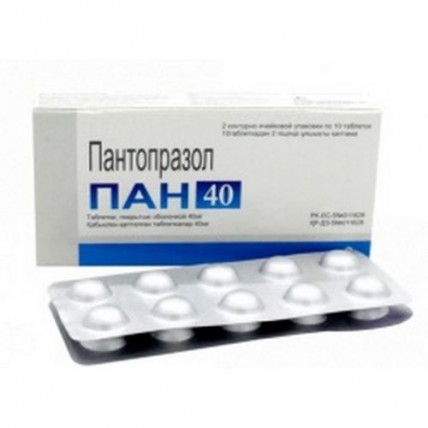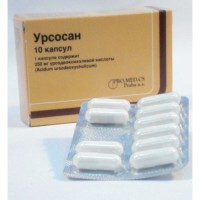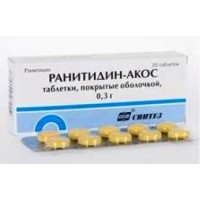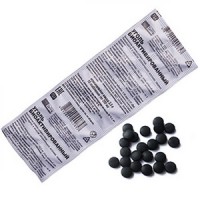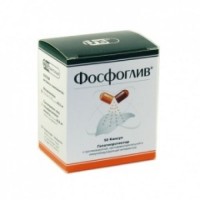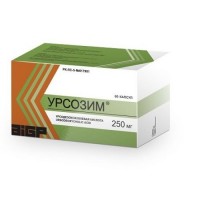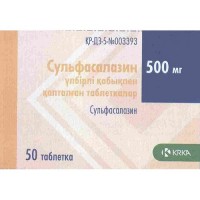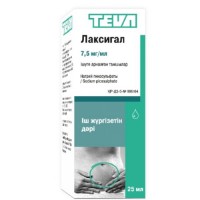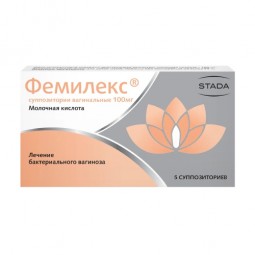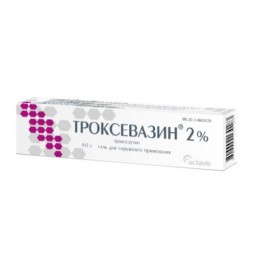Pan -40 20s 40 mg coated tablets
- $13.40
The instruction for medical use of Sir-40 Sir-20 medicine the Trade name the Sir-20 the Sir-40 the International unlicensed name Pantoprazol Lekarstvennaya the Tablet form, coated 20 mg, 40 mg One tablet contains Structure: active agent: sodium of a pantoprazol of 22.74 mg or 45.48 mg (it is equivalent to a patoprazol of 20 mg or 40 mg), excipients: sodium a carbonate monohydrate, Mannitolum 60, krospovidon, K-2 polyvinylpirrolidone, polysorbate – 80, sodium lauryl sulfate, calcium stearate, iron oxide yellow, a cover - Opadry® II 85G68918 (white) - polyvinyl alcohol, the titan dioxide (E 171), a macrogoal, soy lecithin, EZE 93086825 acrylic (brown) - copolymer of methacrylic acid (type C), talc, the titan dioxide (E171), ferrous oxide yellow (E172), ferrous oxide red (E172), trietit citrate, silicon dioxide colloidal, sodium bicarbonate, sodium lauryl sulfate the Description of the Tablet, coated light brown color, round, biconvex (for a dosage of 20 mg). Tablets, coated dark brown color, round, biconvex (for a dosage of 40 mg). Pharmacotherapeutic group Drugs for treatment of the diseases connected with disturbance of acidity. Antiulcerous drugs and drugs for treatment of a gastroezofagalny reflux. Inhibitors of the protonew pump. Pantoprazol the ATX A02BC02 Code the Pharmacological Pharmacokinetics Absorption properties and distribution Pantoprazol is applied orally in the form of the tablet covered with a kishechnorastvorimy cover. Absorption happens in a small intestine. The maximum concentration in blood plasma after reception of a dose of 40 mg - 2-3¼¬ú/ml is reached in 2.5 hours and remains constant after repeated use. The absolute bioavailability of Pantoprazol is about 77%. The pharmacokinetics is linear in the range of doses of 10-80 mg (in proportion to increase in a dose AUC and Cmax increases). Linking with proteins of blood plasma – approximately for 98%. Metabolism Pantoprazol is almost completely metabolized in a liver. The main metabolite dimetilpantoprazol is conjugated by sulfates. Removal Is removed mainly with urine (80%) in the form of metabolites, in a small amount it is found in Calais. The half-life period of the main metabolite is about 1.5 hours. At patients with cirrhosis the half-life period increases till 7 - 9 o'clock. AUC values increases from 6 to 8 while the maximum serological concentration increases only by a half. In a renal failure the half-life period of the main metabolite slightly increases, but T1/2 of the main metabolite reaches 2-3 hours. Pantoprazol is badly dialyzed. AUC and Cmax are slightly higher in the senior age group. The pharmacodynamics Pantoprazol is the substituted benzimidazole which is slowing down secretion of hydrochloric acid in a stomach by specific impact on a proton pomp of covering cells. In acidic environment of covering cells pantoprazol turns into the active form – cyclic sulphenamide where it suppresses enzyme H+, K+-ATFazu. Blocking the proton pump, pantoprazol interferes with process of a kislotoobrazovaniye at the level of a final stage of synthesis of hydrochloric acid in a stomach. Inhibiting effect dozozavisimo also influences the level of basal and stimulated secretion of hydrochloric acid (irrespective of a type of an irritant). In a peptic ulcer of a stomach and the duodenum associated with Helicobacter pylori, such decrease in gastric secretion increases sensitivity of a microorganism to antibiotics. After oral administration of Pantoprazol the anti-secretory effect occurs in 1 hour and reaches a maximum in 2 - 4 hours. Does not affect motility of digestive tract. The secretory activity is restored to initial level in 3 - 4 days after the end of reception. Pantoprazol has big chemical stability at a neutral rn, and the smaller potential of interaction with other medicines. Indications - a reflux esophagitis - a peptic ulcer of a stomach and duodenum including associated with Helicobacter pylori in a combination with antibacterial drugs - Zollingera-Ellison's syndrome or other states which are characterized by pathological gastric hypersecretion the Route of administration and doses the Average therapeutic dose makes 20 mg a day. Single daily dose of Pantoprazol is recommended in the morning. Pantoprazol a pill is taken inside entirely (without making small and without dissolving), washing down with enough liquid in 1 hour prior to a breakfast. The reflux esophagitis to the Adult is appointed single daily dose of 20 mg / 40 mg of a pantoprazol within 4 weeks, in case of need increase in a course up to 8 weeks. For maintenance therapy drug is appointed in a dose from 20 to 40 mg a day. Peptic ulcer of a stomach and duodenum: usually 40 mg a day once. Course duration treatment in a peptic ulcer of a duodenum is from 2 to 4 weeks, in a peptic ulcer of a stomach - from 4 to 8 weeks. The recommended dose at antirecurrent treatment of a peptic ulcer of a stomach and a 12-perstny gut – on 20 mg a day. Eradikation Helicobacter pylori: Pantoprazol's combination with antibiotics is possible: The sir on 40 mg 2 times a day + amoxicillin on 1 g 2 times a day + klaritromitsin on 500 mg 2 times a day of Ban on 40 mg 2 times a day + metronidazole on 400 - 500 mg 2 times a day (or 500 mg of Tinidazolum) + klaritromitsin on 250 - 500 mg 2 times a day of Ban on 40 mg 2 times a day + amoxicillin on 1 g 2 times a day + metronidazole on 400 - 500 mg 2 times a day (or 500 mg of Tinidazolum). In case of combination therapy for an eradikation of H. pylori, the second tablet has to be used in 1 hour prior to evening meal. Combination therapy is carried out within 7 days and 7 more days can be continued (the general duration of treatment up to 2 weeks). Further treatment is possible after consideration of recommendations about drug dosing in an ulcer of a duodenum and stomach. Zollinger-Ellison's syndrome: initial dose of 80 mg. At administration of drug more than 80 mg a day, drug is recommended to accept 2 times. The course of treatment depends on clinical need. Use in a liver failure: at patients with the profound abnormal liver functions the daily dose of drug should not exceed 20 mg. It is not necessary to apply Ban in combination therapy to Helicobacter pylori eradikation at patients with moderate and heavy abnormal liver functions. Dose adjustment is not required to patients of advanced age and patients with renal failures Side effects Below the observed side reactions with a frequency of their occurrence are listed: very often ( 1/10), it is frequent (from 1/00 to 1/10), infrequently (from 1/1000 to 1/100), is rare (from 1/10000 to 1/1000), very seldom ( 1/10000), it is unknown (it is impossible to estimate on the available data). Infrequently a headache, dizziness dryness in a mouth, nausea, vomiting, an abdominal distension, abdominal pain and discomfort, diarrhea, a constipation skin rash, an itching, a dieback an asthenia, fatigue and an indisposition increase in activity of liver enzymes (transaminases, -GT) a sleep disorder Seldom an agranulocytosis hypersensitivity to active and to auxiliary components of drug (including anaphylactic reactions and an acute anaphylaxis) a lipidemia, increase in level of triglycerides, cholesterol increase in content of bilirubin change of weight, disturbance of taste a depression (and all accompanying deteriorations) disorder of vision / illegibility of sight urticaria, a Quincke's disease an arthralgia, myalgia a gynecomastia Very seldom thrombocytopenia, a leukopenia, a pancytopenia a disorientation (and all accompanying deteriorations) Does not know fervescence, peripheral hypostases a hyponatremia, a hallucination hypomagnesiemia, confusion of consciousness (especially at the patients predisposed to these states and also deterioration in these symptoms if they existed prior to treatment) hepatocellular damages, jaundice, hepatocellular insufficiency Stephens-Johnson's syndrome, a Lyell's disease, an exudative mnogoformny erythema, photosensitivity interstitial nephrite - an acute anaphylaxis. Contraindications - hypersensitivity to a pantoprazol or other components of drug - the profound abnormal liver functions and kidneys - combined use of a pantoprazol with atazanaviry. Medicinal interactions It is necessary to pay attention to a concomitant use with drugs which absorption is rn-dependent, for example ketokonazol, itrakonazol, pozakonazol, erlotinib, including with the drugs appointed shortly before a course of treatment Pantoprazol in view of change of absorption of these drugs. The concomitant use of Pantoprazol and an atazanavir considerably reduces efficiency of the last. At combined use of a fenprokumon or warfarin, several isolated cases of change of the International normalizing relation were celebrated (MNO or INR). Therefore for the patients undergoing treatment by coumarinic anticoagulants (for example, fenprokumony or warfarin), it is recommended to watch a prothrombin time / MNO after the beginning, the termination or during irregular use of Pantoprazolom. Pantoprazol has the low potential of interaction with the system of P450 cytochrome. Therefore the risk of the side reactions caused by Pantoprazol's interaction with other drugs which is metabolized a system P450 cytochrome can be considered as minimum. Special researches did not reveal clinically significant interaction of Pantoprazol with caffeine, carbamazepine, diazepam, ethanol, diclofenac, glibenclamide, Naproxenum, metoprololy, nifedipine, Phenytoinum, piroxicam, theophylline, the oral contraceptives containing levonorgestrel and ethinylestradiol. At a concomitant use with antibiotics, such as klaritromitsin and amoxicillin, with metronidazole, interactions it is not revealed. Interaction with antacids at a concomitant use is not revealed. At patients with heavy abnormal liver functions at Pantoprazol's reception, especially during the long period, regular control of level of enzymes of a liver is recommended to carry out special instructions. At increase in level of liver enzymes it is necessary to stop drug use. Carrying out endoscopic control for confirmation of the diagnosis an esophagitis reflux is obligatory. At treatment by Pantoprazol the expressiveness of symptoms of malignant diseases can decrease that can delay establishment of the correct diagnosis, in communication with what before an initiation of treatment it is necessary to exclude a possibility of a malignant new growth. Patients have to consult with the doctor in the following cases: - if symptoms did not pass within 2 weeks, - involuntary weight reduction of a body, anemia, gastrointestinal bleeding, a dysphagy, persistent vomiting or vomiting with blood, in these cases, it is necessary to exclude existence of malignant process, - earlier there was stomach ulcer, or the undergone surgery on a stomach, - disturbances of digestion or heartburn within 4 or more weeks, - jaundice, dysfunctions or diseases of a liver, - any other serious disease influencing overall health - patients is more senior than 55 years in the presence of the new or recently changed symptoms. Patients at whom long-term recurrent symptoms of disturbance of digestion or heartburn are observed have to see a doctor. At patients with Zollingera-Ellison's syndrome and other morbid hyper secretory conditions which treatment demands long reception of Pantoprazol as the drug blocking secretion of acid in a stomach reduction of absorption of B12 vitamin (cyanocobalamine) owing to hypo - or achlorhydrias is possible. It should be considered in the presence of the corresponding clinical symptoms. At the long period of administration of drug, patients have to be under regular observation. Lowering of acidity of a stomach increases quantity of gastric bacteria which usually are present at digestive tract. Treatment by the drugs lowering acidity leads to increase in risk of developing the gastrointestinal infections caused by such microorganisms as Salmonella, Campylobacter. Use in pediatrics of Data on use of the drug Pantoprazola for children and teenagers up to 18 years in a peptic ulcer of a stomach and duodenum, Helicobacter pylori eradikation, a reflux esophagitis and Zollingera-Ellison's syndrome is not available. Use of drug at children's and teenage age is not recommended. Pregnancy and the period of a lactation of Adequate data on use of a pantoprazol at pregnancy are not present. Researches on animals demonstrate reproductive toxicity of drug. Pantoprazol should not be applied during pregnancy. The lactation for drug treatment is stopped. The feature of influence of medicine on ability to run the vehicle or potentially dangerous mechanisms Should refrain from control of the vehicles and other mechanisms requiring special attention because of the probability of dizzinesses and a disorder of vision. Overdose Symptoms: strengthening of severity of side effects, a disorder of vision, drowsiness, excitement, a headache, increase in sweating, dryness in a mouth, nausea, tachycardia. Treatment: drug withdrawal. Specific antidote does not exist. Symptomatic therapy. Drug is not removed by means of a hemodialysis. The form of release and packing On 10 tablets place in blister strip packaging from a film of polyvinylchloride and aluminum foil. On 2 blister strip packagings together with the instruction for medical use in the state and Russian languages place in a cardboard box. To Store storage conditions in the dry, protected from light place at a temperature not above 25 °C. To store out of children's reach! 3 years not to use a period of storage after the expiry date specified on packing. Prescription status According to the prescription Producer Alkem Laboratories Ltd, Mumbai, India the Owner of the registration certificate of "Alkem Laboratories Ltd", India
to Develop the Address of the organization accepting in the territory of the Republic of Kazakhstan claims from consumers on quality of products (goods) Representative office of Alkem Laboratories Limited Almaty, Mametov St. 67
to Develop the Address of the organization accepting in the territory of the Republic of Kazakhstan claims from consumers on quality of products (goods) Representative office of Alkem Laboratories Limited Almaty, Mametov St. 67
